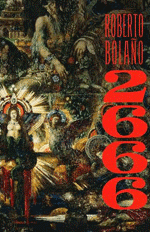Angrama Press (2004)/ Farrar, Strauss and Giroux (2008)
Review by Matt Pincus
2666, Bolaño’s last novel, which could easily be seen as five interconnected novels, is a literary classic in a young century. It is extremely rare for a Latin American – or any international author – to be translated into English, published and distributed by a major house like FSG. The almost nine hundred pages are well worth a reader’s time, as the narrator takes an underlying lucidness to the prose that builds on itself through plot inconsistencies. Bolaño knows our genre expectations as reader, and carries one on those expectations, only to continually create gaps where a “fiction-making system” is created, as translator and scholar Chris Andrews says. 2666 opens old wounds of history in the land, and exposes the trauma of a community governed by evil.
The text is separated into five parts, and each of these sections has a separate genre: academic satire, thriller, detective fiction, beat novel, and historical romance. They all center on the town of Santa Teresa, a fictional border-city in Mexico, much like Ciudad Juárez. The academics come to the city to find Benno Von Archimboldi, the writer, who is nowhere to be found. Amalfitano, a professor at the university, is hanging geometric figures on his clothesline, delving into philosophical digressions as his daughter goes in and out of the house. Fate is an African American reporter from New York sent for an article about a boxing match when he starts to learn about the murders of women in the city.Bolaño, through each part of the novel, starts to systematically expose one the underlying systemic, infrastructural issues of Santa Teresa. The academics watch bloody fights between taxi drivers and hotel management. Amalfitano senses his daughter’s boyfriend is a drug-dealer and also partly responsible for the dead women in Santa Teresa. Fate runs into Amalfitano’s daughter and saves her from the men who were going to murder her.
“The Part about the Crimes,” the fourth and longest section of the text, becomes a systematic, clinical dissection of both a societal, economic and further, a mythical curse upon the city. Over a hundred dead woman are catalogued, some raped, others with fractured hyoid bones, and others still who are unidentified, unknown. A reader looking for a serial killer responsible for the murders and a resolution to justice will only find “hidden centers,” as the prominent Spanish literary critic Ignacio Echevarría notes. A homicide case of a maquiladora worker or dancer found in a vacant lot or landfill will go unsolved, and the haunting, hollow words at the end of many of these sections is, “The case was soon closed.”
NAFTA’s trade agreement, enacted in 1992, paved the way for American corporations to set up large factories across the border that ran twenty-four hours and paid (still pay) workers about $8.50 a day. Many of these women with shifts early in the morning and without public transportation, would walk two or three miles in the dark in a town run by drug cartels. Later, one learns the cartels have paid off the police chief, the mayor, and a senate legislator in their county to look the other way. A prominent businessman who runs landfills and waste services in Santa Teresa also has a close affiliation with the drug cartels.
A sinister evil lurks in the town of Santa Teresa. Bolaño’s epigraph from Baudelaire rightly conjures the city: “An oasis of horror in a desert of boredom.” Reading over a hundred clinical descriptions of dead women is chilling, but it is even more horrifying to know that the “oasis of horror” is created by “the desert of boredom.” The scholars in the first section, when they arrive in the city, end up at a dead end in their search for Archimboldi, and instead drink out by the hotel pool and read. Amalfitano spends the course of his narrative amusing himself in a farfetched replication of a Duchamp readymade at his home. Fate, although he starts to uncover bits and pieces of what is occurring in the city, drinks at clubs, spends time with the friends he meets at the boxing match, and stands by as witness. Many of the policemen spend their time filling out paperwork or eating at restaurants around Santa Teresa. The town’s community is broken by the fear, paranoia, and carnage of killers who murder for what seems like sport among vulnerable citizens without consequence.
In “The Part about Arcimboldi,” the writer hears the confession in a prison camp at the end of WWII of Leo Sammer. a Nazi who supplied workers to factories in Poland. Five hundred Greek Jews arrive on train by mistake that were supposed to be sent to Auschwitz. He is told to murder them. Sammer organizes policeman and volunteers to shoot them, and bury their bodies in the forest. He observes, after burying hundreds of bodies, they have run out of room because the graves were dug horizontally, instead of vertically. He says, “Remember the idea isn’t to find things, it’s to not find them.”
Bolaño’s evil exists in willful, conscious ignorance. He wishes to find the very sources of what makes evil, what justifies genocide, and expose it through the freedom of an imaginary metropolis, ever so real to the world of the Americas and also an elusive ghost town, with the worst of humanity’s ethical failures.
***
Matt Pincus was born and raised in San Diego, CA. He attends the Jack Kerouac School’s MFA program in Boulder, CO, and recently published an essay on Dodie Bellamy in Coldfront. He has also written reviews for Bookslut, Pank, Necessary Fiction, and The Volta blog.
![[PANK]](https://pankmagazine.com/wp-content/themes/pank/assets/images/pank-logo-large.png)

